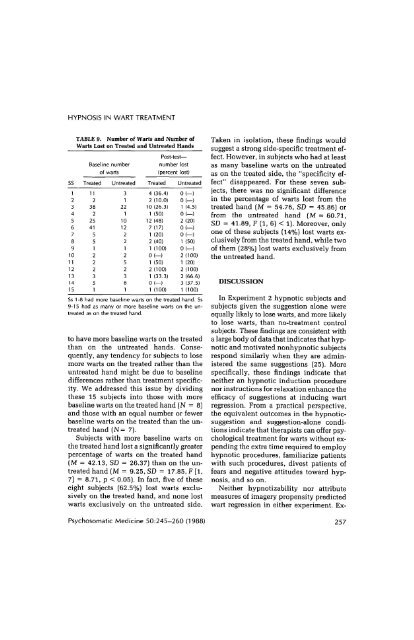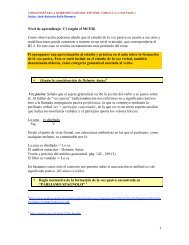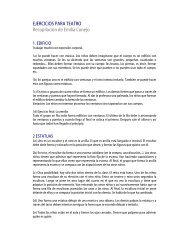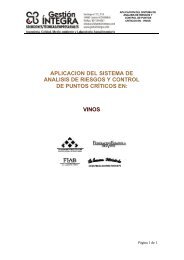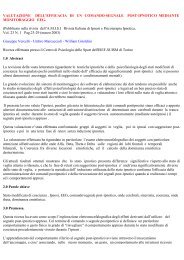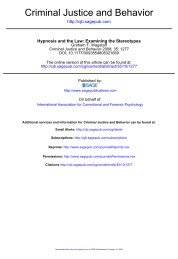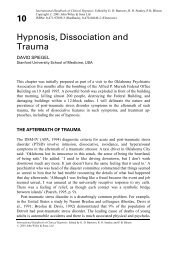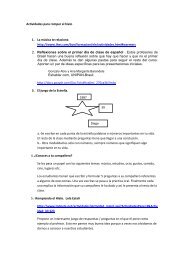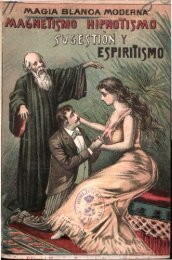Hypnosis, Placebo, and Suggestion in the Treatment of Warts
Hypnosis, Placebo, and Suggestion in the Treatment of Warts
Hypnosis, Placebo, and Suggestion in the Treatment of Warts
You also want an ePaper? Increase the reach of your titles
YUMPU automatically turns print PDFs into web optimized ePapers that Google loves.
HYPNOSIS IN WART TREATMENTTABLE 9. Number <strong>of</strong> <strong>Warts</strong> <strong>and</strong> Number <strong>of</strong><strong>Warts</strong> Lost on Treated <strong>and</strong> Untreated H<strong>and</strong>sBasel<strong>in</strong>e number<strong>of</strong> wartsPost-test—number lost(percent lost)SS Treated Untreated Treated Untreated11238225415512223513122110122212523814 (36.4)2 (10.0)10 (26.3)1 (50)12 (48)7(17)1 (20)2 (40)1 (100)0(—)1 (50)2 (100)1 (33.3)0(—)1 (100)1 (4.5)2 (20)1 (50)0(—)2(100)1 (20)2 (100)2 (66.6)3 (37.5)1 (100)Ss 1-8 had more basel<strong>in</strong>e warts on <strong>the</strong> treated h<strong>and</strong>. Ss9-15 had as many or more basel<strong>in</strong>e warts on <strong>the</strong> untreatedas on <strong>the</strong> treated h<strong>and</strong>.to have more basel<strong>in</strong>e warts on <strong>the</strong> treatedthan on <strong>the</strong> untreated h<strong>and</strong>s. Consequently,any tendency for subjects to losemore warts on <strong>the</strong> treated ra<strong>the</strong>r than <strong>the</strong>untreated h<strong>and</strong> might be due to basel<strong>in</strong>edifferences ra<strong>the</strong>r than treatment specificity.We addressed this issue by divid<strong>in</strong>g<strong>the</strong>se 15 subjects <strong>in</strong>to those with morebasel<strong>in</strong>e warts on <strong>the</strong> treated h<strong>and</strong> (N = 8)<strong>and</strong> those with an equal number or fewerbasel<strong>in</strong>e warts on <strong>the</strong> treated than <strong>the</strong> untreatedh<strong>and</strong> (N= 7).Subjects with more basel<strong>in</strong>e warts on<strong>the</strong> treated h<strong>and</strong> lost a significantly greaterpercentage <strong>of</strong> warts on <strong>the</strong> treated h<strong>and</strong>(M = 42.13, SD = 26.37) than on <strong>the</strong> untreatedh<strong>and</strong> (M = 9.25, SD = 17.85, F [1,7] = 8.71, p < 0.05). In fact, five <strong>of</strong> <strong>the</strong>seeight subjects (62.5%) lost warts exclusivelyon <strong>the</strong> treated h<strong>and</strong>, <strong>and</strong> none lostwarts exclusively on <strong>the</strong> untreated side.Taken <strong>in</strong> isolation, <strong>the</strong>se f<strong>in</strong>d<strong>in</strong>gs wouldsuggest a strong side-specific treatment effect.However, <strong>in</strong> subjects who had at leastas many basel<strong>in</strong>e warts on <strong>the</strong> untreatedas on <strong>the</strong> treated side, <strong>the</strong> "specificity effect"disappeared. For <strong>the</strong>se seven subjects,<strong>the</strong>re was no significant difference<strong>in</strong> <strong>the</strong> percentage <strong>of</strong> warts lost from <strong>the</strong>treated h<strong>and</strong> (M = 54.76, SD = 45.86) orfrom <strong>the</strong> untreated h<strong>and</strong> (M = 60.71,SD = 41.89, F (1, 6) < 1). Moreover, onlyone <strong>of</strong> <strong>the</strong>se subjects (14%) lost warts exclusivelyfrom <strong>the</strong> treated h<strong>and</strong>, while two<strong>of</strong> <strong>the</strong>m (28%) lost warts exclusively from<strong>the</strong> untreated h<strong>and</strong>.DISCUSSIONIn Experiment 2 hypnotic subjects <strong>and</strong>subjects given <strong>the</strong> suggestion alone wereequally likely to lose warts, <strong>and</strong> more likelyto lose warts, than no-treatment controlsubjects. These f<strong>in</strong>d<strong>in</strong>gs are consistent witha large body <strong>of</strong> data that <strong>in</strong>dicates that hypnotic<strong>and</strong> motivated nonhypnotic subjectsrespond similarly when <strong>the</strong>y are adm<strong>in</strong>istered<strong>the</strong> same suggestions (25). Morespecifically, <strong>the</strong>se f<strong>in</strong>d<strong>in</strong>gs <strong>in</strong>dicate thatnei<strong>the</strong>r an hypnotic <strong>in</strong>duction procedurenor <strong>in</strong>structions for relaxation enhance <strong>the</strong>efficacy <strong>of</strong> suggestions at <strong>in</strong>duc<strong>in</strong>g wartregression. From a practical perspective,<strong>the</strong> equivalent outcomes <strong>in</strong> <strong>the</strong> hypnoticsuggestion<strong>and</strong> suggestion-alone conditions<strong>in</strong>dicate that <strong>the</strong>rapists can <strong>of</strong>fer psychologicaltreatment for warts without expend<strong>in</strong>g<strong>the</strong> extra time required to employhypnotic procedures, familiarize patientswith such procedures, divest patients <strong>of</strong>fears <strong>and</strong> negative attitudes toward hypnosis,<strong>and</strong> so on.Nei<strong>the</strong>r hypnotizability nor attributemeasures <strong>of</strong> imagery propensity predictedwart regression <strong>in</strong> ei<strong>the</strong>r experiment. Ex-Psychosomatic Medic<strong>in</strong>e 50:245-260 (1988) 257


